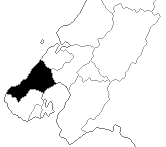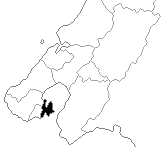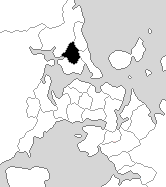
Onslow was a New Zealand parliamentary electorate, from 1946 to 1963, and then from 1993 to 1996 in the Wellington area. It was represented by three Members of Parliament.

Onslow was a New Zealand parliamentary electorate, from 1946 to 1963, and then from 1993 to 1996 in the Wellington area. It was represented by three Members of Parliament.
The 1941 New Zealand census had been postponed due to World War II, so the 1946 electoral redistribution had to take ten years of population growth and movements into account. The North Island gained a further two electorates from the South Island due to faster population growth. The abolition of the country quota through the Electoral Amendment Act, 1945 reduced the number and increased the size of rural electorates. None of the existing electorates remained unchanged, 27 electorates were abolished, eight former electorates were re-established, and 19 electorates were created for the first time, including Onslow. [1]
The electorate covered the northern suburbs of the city of Wellington, i.e. Ngaio, Khandallah and Johnsonville. The name Onslow comes from the former Borough of Onslow which covered Wadestown until April 1907 its south ward and its most populous area [2] and the remaining Khandallah Ngaio areas until they too joined Wellington City in 1919.
The electorate was established for the 1946 election.
The unsuccessful National candidate in 1954 was Wilfred Fortune, who had represented Eden in Auckland from 1946 to 1954.
The electorate lasted until the 1963 election, when the Karori electorate was established.
The electorate was re-established in the 1993 election to replace Ohariu. Peter Dunne, who had previously represented the Ohariu electorate, was the successful candidate. [3] For the first MMP election, the 1996 election, it was renamed back to Ohariu-Belmont, and included Belmont in the Hutt Valley.
The Onslow electorate was represented by three Members of Parliament. [4]
Key
Labour Independent Future United NZ
| Elections | Winner | |
|---|---|---|
| 1946 election | Harry Combs | |
| 1949 election | ||
| 1951 election | ||
| 1954 by-election | Henry May | |
| 1954 election | ||
| 1957 election | ||
| 1960 election | ||
| (Electorate abolished 1963–1993) | ||
| 1993 election | Peter Dunne | |
| (Electorate abolished in 1996; see Ohariu-Belmont) | ||
| Party | Candidate | Votes | % | ±% | |
|---|---|---|---|---|---|
| Labour | Peter Dunne | 9,096 | 41.61 | ||
| National | George Mathew | 8,031 | 36.74 | ||
| Alliance | Phillida Bunkle | 3,077 | 14.07 | ||
| NZ First | Elisabeth Burgess | 682 | 3.12 | ||
| Christian Heritage | Colin Byford | 457 | 2.09 | ||
| Independent | Sarah Lysaght | 296 | 1.35 | ||
| McGillicuddy Serious | Thomas Barker | 130 | 0.59 | ||
| Natural Law | Mary-Anne McGregor | 62 | 0.28 | ||
| Independent | Keith Leslie Stewart | 24 | 0.10 | ||
| Majority | 1,065 | 4.87 | |||
| Turnout | 21,855 | 86.98 | |||
| Registered electors | 25,126 | ||||
| Party | Candidate | Votes | % | ±% | |
|---|---|---|---|---|---|
| Labour | Henry May | 8,670 | 45.25 | -10.72 | |
| National | Maida Clark | 7,880 | 41.12 | ||
| Social Credit | Eric Elliott | 920 | 4.80 | ||
| Communist | Sydney Smith | 101 | 0.52 | ||
| Majority | 790 | 4.12 | -12.73 | ||
| Turnout | 17,571 | 91.70 | -2.99 | ||
| Registered electors | 19,160 | ||||
| Party | Candidate | Votes | % | ±% | |
|---|---|---|---|---|---|
| Labour | Henry May | 8,882 | 55.97 | +7.20 | |
| National | Kevin O'Brien | 6,207 | 39.11 | ||
| Social Credit | Frederick Buckley | 779 | 4.90 | ||
| Majority | 2,675 | 16.85 | +13.65 | ||
| Turnout | 15,868 | 94.69 | +5.08 | ||
| Registered electors | 16,757 | ||||
| Party | Candidate | Votes | % | ±% | |
|---|---|---|---|---|---|
| Labour | Henry May | 7,898 | 48.77 | ||
| National | Wilfred Fortune | 7,379 | 45.56 | ||
| Social Credit | Barney Thomas Daniel | 916 | 5.65 | ||
| Majority | 519 | 3.20 | |||
| Turnout | 16,193 | 89.61 | |||
| Registered electors | 18,070 | ||||
| Party | Candidate | Votes | % | ±% | |
|---|---|---|---|---|---|
| Labour | Henry May | unopposed | |||
| Party | Candidate | Votes | % | ±% | |
|---|---|---|---|---|---|
| Labour | Harry Combs | 9,539 | 53.08 | -6.76 | |
| National | Jack Meadowcroft | 8,433 | 46.92 | +0.64 | |
| Majority | 1,106 | 6.15 | -6.12 | ||
| Turnout | 17,972 | 90.62 | -4.44 | ||
| Registered electors | 19,831 | ||||
| Party | Candidate | Votes | % | ±% | |
|---|---|---|---|---|---|
| Labour | Harry Combs | 9,391 | 59.84 | +4.27 | |
| National | Jack Meadowcroft | 7,464 | 47.56 | ||
| Majority | 1,927 | 12.27 | +1.15 | ||
| Turnout | 15,693 | 86.18 | -6.64 | ||
| Registered electors | 18,209 | ||||
| Party | Candidate | Votes | % | ±% | |
|---|---|---|---|---|---|
| Labour | Harry Combs | 7,880 | 55.57 | ||
| National | Philip Patrick Lynch | 6,302 | 44.43 | ||
| Majority | 1,578 | 11.12 | |||
| Turnout | 14,182 | 92.82 | |||
| Registered electors | 15,278 | ||||
Karori was a New Zealand electorate, situated in the west of Wellington. It existed from 1946 to 1978, and was represented by three different Members of Parliament during that period, all of them are represented by National Party due to being a wealthy suburb.

Wellington Central is an electorate, represented by a Member of Parliament in the New Zealand House of Representatives. The current MP for Wellington Central is Tamatha Paul of the Green Party. She has held this position since the 2023 general election.

Ōhāriu, previously spelled Ohariu and then Ōhariu, is a New Zealand parliamentary electorate returning one Member of Parliament to the House of Representatives. It first existed from 1978 to 1993, and was recreated for the 2008 election. In 2008, it was the successor to Ohariu-Belmont, first contested at the first mixed-member proportional (MMP) election in 1996. Through its existence Ohariu-Belmont was represented by Peter Dunne, leader of the United Future party. Dunne contested and won the recreated electorate in 2008. He announced on 21 August 2017 that he would not stand in the 2017 general election.
Brooklyn was a New Zealand parliamentary electorate in Wellington city from 1946 to 1954. It was represented by two prominent members of the Labour Party: Peter Fraser, who was Prime Minister (1940–1949), and Arnold Nordmeyer, who was later Minister of Finance (1957–1960).

Island Bay was a former New Zealand electorate, centred on Island Bay in the southern suburbs of Wellington. The electorate was formed in 1946 and dissolved in 1996.

Miramar was a New Zealand parliamentary electorate in the south-eastern suburbs of Wellington. It was created in 1946, replacing Wellington East, and was replaced by Rongotai for the first MMP election of 1996.
Petone is a former parliamentary electorate in the lower Hutt Valley of New Zealand, from 1946 to 1978. The electorate was represented by two Members of Parliament from the Labour Party.
Otahuhu is a former New Zealand parliamentary electorate in the southern suburbs of the city of Auckland, from 1938 to 1963, and then from 1972 to 1984.

Onehunga, initially with the formal name of Town of Onehunga, is a former New Zealand parliamentary electorate in the south of the city of Auckland. Between 1861 and 1881, and between 1938 and 1996, it was represented by seven Members of Parliament. It was a stronghold for the Labour Party.
Kapiti was a New Zealand parliamentary electorate, from 1972 to 1996. A bellwether electorate, it frequently changed between National and Labour.

Glenfield was a New Zealand parliamentary electorate for four terms, from 1984 to 1996. It was represented by two members of parliament, first Judy Keall of the Labour Party, and then Peter Hilt of the National Party. Hilt defected to United New Zealand in 1995.
Hobson is a former New Zealand parliamentary electorate. It existed from 1946 to 1978 and then from 1987 to 1996, and was represented by five Members of Parliament, four of whom represented the National Party. It is notable for returning a member of the Social Credit Party in the 1966 election, as no other candidate not aligned with either Labour or National had been elected to Parliament since 1943. With the re-drawing of boundaries in the first MMP election in 1996, the seat was absorbed into the Northland and Whangarei electorates.
Fendalton is a former New Zealand parliamentary electorate. It existed during two periods between 1946 and 1996. The electorate was in the western suburbs of Christchurch, New Zealand. Fendalton is an expensive suburb, and was always represented by the National Party.
St Kilda is a former New Zealand parliamentary electorate. It existed from 1946 to 1996 and was represented by four Members of Parliament.
Marlborough is a former New Zealand parliamentary electorate, in the Marlborough region at the top of the South Island. It existed from 1938 to 1996, and was represented by five Members of Parliament.
Mornington is a former parliamentary electorate from 1946 to 1963, centred on the suburb of Mornington in the city of Dunedin, New Zealand.
St Albans was a parliamentary electorate in Christchurch, New Zealand from 1881 to 1890, then from 1946 to 1996.
Ponsonby was a parliamentary electorate in Auckland, New Zealand from 1887 to 1890 and from 1946 to 1963. The Ponsonby electorate was represented by two Members of Parliament.
Hastings was a parliamentary electorate in the Hawke's Bay Region of New Zealand from 1946 to 1996. The electorate was represented by nine Members of Parliament. The Hastings electorate was a typical bellwether electorate, frequently changing between the two main parties.
Ohariu-Belmont was a New Zealand parliamentary electorate from 1996 to 2008.